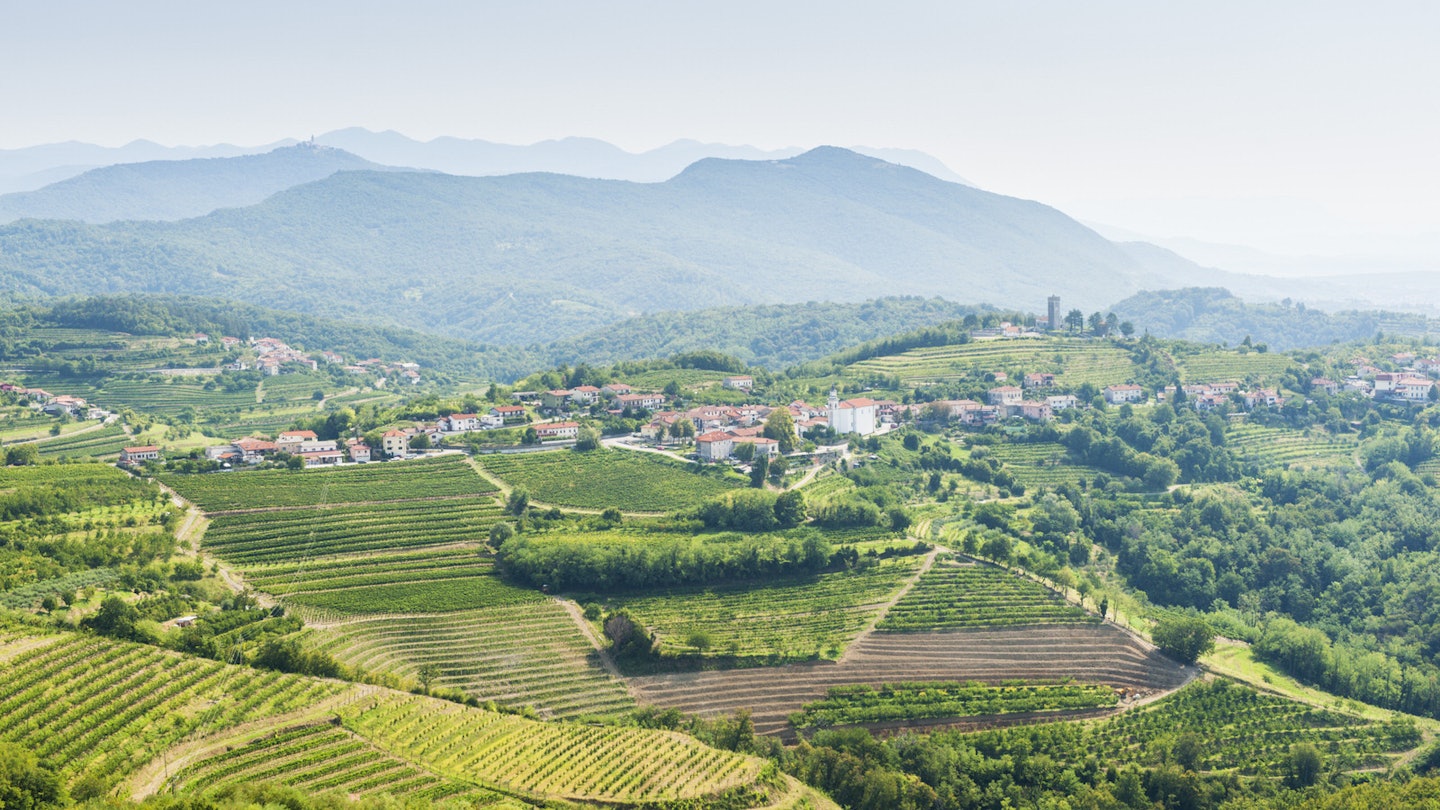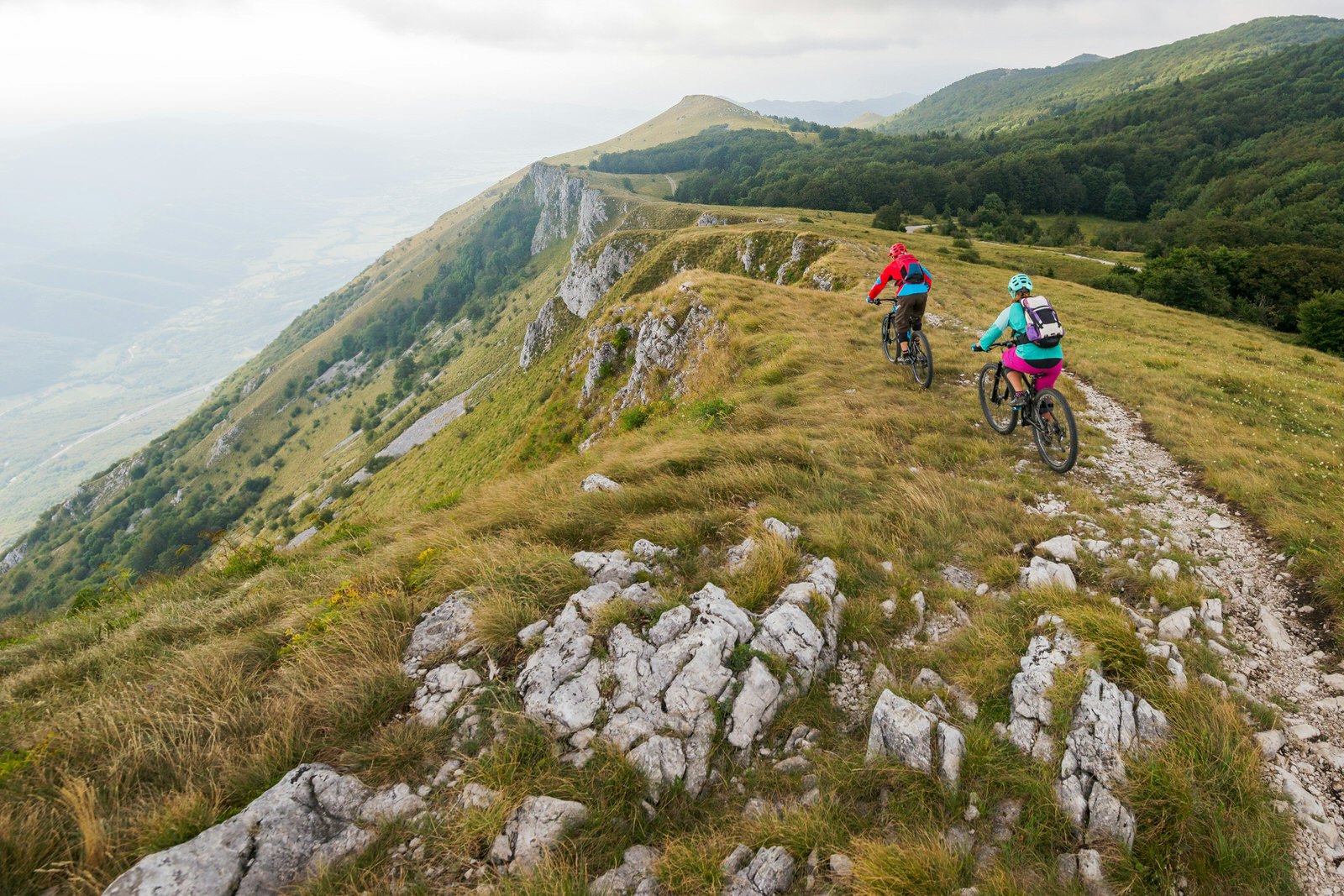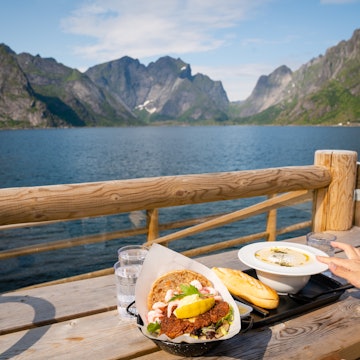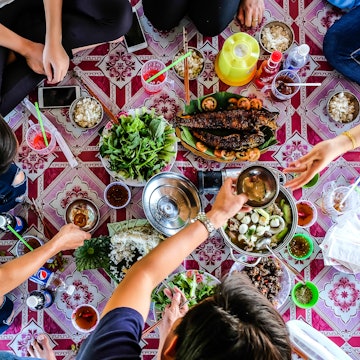

Tucked away between the towering Julian Alps and the Adriatic coast, Slovenia’s bucolic western winelands are often overlooked by visitors. But despite falling under the radar, this is a region rich in appeal and charm – from boutique wine tasting and gastronomic surprises to adrenaline-fuelled adventures, and all with a picture-perfect backdrop.

Beautiful landscapes
Edged by great karst mountains, their limestone rocks peeking out above the forests, the Vipava Valley may only be a short hop from the capital Ljubljana, but it feels a million miles from the city. Grape-heavy rows of vines spread out across the valley floor, interrupted now and again by terracotta-topped hamlets, their roofs weighed down with rocks to save the tiles from the ferocious bora wind that rattles through the valley in winter. Verdant gorges and white-grey rock stacks litter the limestone Karst area to the south. Further west, nudging against the Italian border, micro-region Goriška Brda’s hills roll deeper, pocked with cypress trees, their brows adorned with gothic stone towers that call to mind picture-perfect Tuscan landscapes – but without the crowds.

Despite the peaceful surrounds, a 90-minute drive from here in any direction will take you places: laid-back Ljubljana to the east, Adriatic beauty Piran to the south, glamorous Venice to the west and the craggy, mountainous playground of the Julian Alps to the north.

Top-quality wines
Most vineyards in the Primorska wine region (which encompasses Vipava, Brda and Karst) are relatively small, family-run estates, so little of their wine is exported. Slovenian winemakers claim that’s because they want to keep it all for themselves – and they’re probably only half joking, because the local varietals produced in Primorska are currently experiencing a surge in popularity. You won’t go far before encountering the oxblood-red Teran, made from Refosco grapes grown in the Karst area in the region’s south, which owes its fiery flavour and wild berry aroma to mineral-heavy limestone soil and salty Mediterranean air. A stone’s throw to the northeast, the indigenous Zelen grape thrives in the windy conditions of the Vipava Valley, producing crisp, herbaceous, easy-drinking whites.

Many of Primoska’s younger generation of winemakers embrace experimental techniques – from organic and pump-free gravitational winemaking to eschewing oak barrels in favour of concrete egg-shaped tanks, which are said to encourage continuous flow of the liquid as it ferments and ages. The vineyards here may be small, but that doesn’t hold them back: their diminutive nature is fast becoming one of the region’s strongest aces, as the appetite for boutique wines and localism grows, attracting visitors who want to sample wines in the region they’ve been made.

Cycling between cellar doors
Put away any notions of fusty wine tastings or guide-led group tours of wine cellars. The cellar door experience in Slovenia’s western winelands feels more like a relaxed get-together among friends. More often than not, it’s the winemakers themselves who meet visitors and lead tastings, showing guests around their estates with pride and splashing out glugs of their wines with satisfying abandon. At Žorž in the Vipava Valley, convivial tastings are held in stone cellars off a sunny courtyard, alongside huge charcuterie platters and the friendly attentions of Labrador Ayesha, who spends her days nosing sticks towards visitors imploringly. Down the road at the Burja estate, it’s hard not to be infected by the enthusiasm of eccentric winemaker Primoz Lavrenčič as he shows guests around his futuristic-looking cellars and sets up impromptu tastings among the barrels.

One of the best ways to explore the region – while sampling its fruits – is on two wheels. Local company Wajdusna organise cycling tours in the region, following the gravel paths and single-track roads that wind their way between grapevines from village to village, and stopping off at cellars for tastings.

Locavore gastronomy
Wedged between Italy to the west and Austria to the north, it’s not surprising that the cuisine of western Slovenia is heavily influenced by its neighbours: pasta, gnocchi and strudel are all local specialities, often to be found on restaurant menus and in home cooking. But Slovenia is no culinary hanger-on. It places great emphasis on producing regional cuisine using fresh, local ingredients, from the humblest of cafes to the country’s top-end restaurants, like the celebrated Hiša Franko restaurant in northwestern Kobarid, helmed by Ana Roš, who was named the world’s best female chef in 2017.

In the western winelands of Slovenia, the breads, cured sausage and nutty cheeses served up in wine cellars and restaurants are always produced locally, and often homemade. Cured meat like pršut owes its flavours to the bora wind that dries it; the high-altitude Tolminc cheese, with its hint of tang, has been made here for centuries.

To experience some of the region’s best ingredients, hunt out Majerija restaurant, close to the tiny village of Slap in the Vipava Valley. Here, surrounded by vineyards, the tasting menu champions local produce – from homemade salami with herb ricotta and Vipava mlinci (a type of flatbread) to cherry cake with cinnamon and thyme plucked from the restaurant’s herb garden.

Outdoor and underground adventures
The Vipava Valley’s bora wind does more than knock tiles from roofs and ripen the grapes. It also carries paragliders high above the valley floor from the limestone peaks, affording them panoramic views of the winelands below. The region offers plenty more outdoor activities for the adventurous. Hikers and cyclists will find trails aplenty amongst beautiful surroundings, and a remarkable lack of traffic to bother them. The steep walls and gorges surrounding the valley provide incredible rock faces for climbers to tackle, with the promise of fantastic views from the top – to the Adriatic, southwards, and the Alps to the north. Year-round campground Park Lijak, based 6km from Nova Gorica, can arrange hiking, cycling, biking and paragliding activities.

To the south, the Karst region is probably best known for its enormous underground caverns, created naturally by the porous limestone terrain. The biggest and best-known are the vast Postojna and Škocjan caves, both of which can be visited on escorted tours. For a more intrepid karst experience, Underground Adventures lead spelunking tours of two of the smaller caves at Postojna, which are not open to regular tours.
Jessica Cole travelled to Slovenia with support from the Slovenian Tourism Board. Lonely Planet contributors do not accept freebies in exchange for positive coverage.













